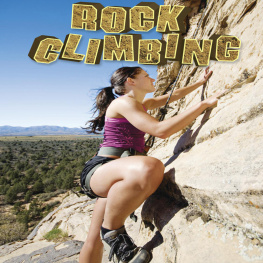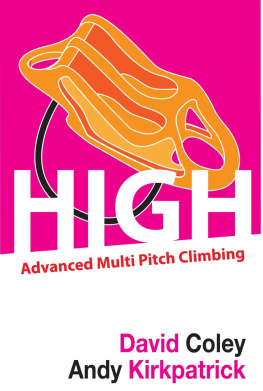Ron Funderburke - Climbing: From Single Pitch to Multipitch
Here you can read online Ron Funderburke - Climbing: From Single Pitch to Multipitch full text of the book (entire story) in english for free. Download pdf and epub, get meaning, cover and reviews about this ebook. publisher: Falcon Guides, genre: Home and family. Description of the work, (preface) as well as reviews are available. Best literature library LitArk.com created for fans of good reading and offers a wide selection of genres:
Romance novel
Science fiction
Adventure
Detective
Science
History
Home and family
Prose
Art
Politics
Computer
Non-fiction
Religion
Business
Children
Humor
Choose a favorite category and find really read worthwhile books. Enjoy immersion in the world of imagination, feel the emotions of the characters or learn something new for yourself, make an fascinating discovery.

- Book:Climbing: From Single Pitch to Multipitch
- Author:
- Publisher:Falcon Guides
- Genre:
- Rating:5 / 5
- Favourites:Add to favourites
- Your mark:
- 100
- 1
- 2
- 3
- 4
- 5
Climbing: From Single Pitch to Multipitch: summary, description and annotation
We offer to read an annotation, description, summary or preface (depends on what the author of the book "Climbing: From Single Pitch to Multipitch" wrote himself). If you haven't found the necessary information about the book — write in the comments, we will try to find it.
Climbing: From Single Pitch to Multipitch — read online for free the complete book (whole text) full work
Below is the text of the book, divided by pages. System saving the place of the last page read, allows you to conveniently read the book "Climbing: From Single Pitch to Multipitch" online for free, without having to search again every time where you left off. Put a bookmark, and you can go to the page where you finished reading at any time.
Font size:
Interval:
Bookmark:
I n a way this is the book that should allow both the readers and the writer to do away with all the fencing that we put around the other books in this series. Multipitch climbing, in theory, should encompass all the disciplines and an appreciation of all the skills that are covered in other texts in this series. It will involve basic toproping skills like anchoring and equipment use, but the typical counterweight arrangement involved in belaying a toprope setup will evolve into various manifestations of direct belaying. Much like any sport climb, this text will involve lead climbing and belaying lead climbing, but leading from a suspended stance or belaying a leader from that stance is substantially different than sport climbing. The leader has the ability to create lead fall forces that are impressively large, and the belayer is then forced to contend with and defend herself from those forces.
Much like traditional climbing, all multipitch climbs can be characterized as an adventurous (and therefore risky) pursuit. But the skills needed to access multipitch climbs unveil risks that dramatically increase in severity. The difference between the risk and commitment involved in any two single-pitch trad climbs can never be as vast or as dangerous as the difference between a two-pitch climb and a twenty-pitch climb. Yet, they are both considered multipitch climbs.
Furthermore, many texts written on the subject of multipitch climbing sustain the myth that there is a distinction between multipitch sport and multipitch trad. In continuation of the distinctions made in our sport-climbing text and our trad-climbing text, this text will dispel that distinction entirely. Because all multipitch climbs create an arrangement where a belayer is suspended in 5th-Class terrain, they all create situations where problems cannot be solved by a quick lower to the ground and an even quicker evacuation. So they all flirt with the unknown in a way that single-pitch climbs do not. Therefore, the presence of permanent anchors and protection bolts seems particularly irrelevant. Retreat from these anchors is only slightly less time-consuming than a cliff without bolts, though abandoning removable anchors is substantially more costly.
The consequences of mishap in a multipitch environment are also dramatically compounded by the size and relative expertise of the climbing team. In single pitch an experienced climber might serve as mentor to an inexperienced climber, and the cost of the learning curve might simply be overall efficiency. By contrast, an inexperienced participant in multipitch climb is usually unequipped to assist his more experienced partner. If she is injured (which is most likely to happen to a lead climber regardless of experience), she cannot rely on her partner to execute a complex improvised rescue. Similarly, large multipitch teams (more than two climbers) necessitate vastly more intricate rope craft, and the time required to complete a large objective multiplies rapidly. Plus, large teams congest tiny ledges and anchors.
In all these distinctions well also have to take some time to explain what multipitch rock climbing is not. Well explore the difference between multipitch free climbing and big-wall climbing, via implements of aid or otherwise. Well have to explore the difference between alpine rock climbing and regular rock climbing. Well have to explore the difference between rock climbing and scrambling, and well have to distinguish multipitch rock from other climbing mediums like ice and snow.

Teams of three require complicated rope work, and they crowd tiny ledges. Teams of three require more-advanced skills.

Snow is actually a hazardous obstacle if its not managed appropriately. Snow is hopefully not a part of multipitch rock climbing.
Accordingly, well define multipitch rock climbing within the following parameters:
A free climb.
A climb that involves a 5th-Class objective.
2nd-, 3rd-, and 4th-Class difficulties may be required to access or egress the 5th-Class objective, but the 5th-Class climbing should be the objective.
The climb requires one or more intermediate belays to ascend and/or descend.
The climbing team consists of two people.
Both members of the climbing team have achieved a minimum competency through ground school, guidance, or instruction.

Mountaineers want to climb mountains; rock climbers want to climb rocks. Mountaineering requires different skills than rock climbing.
| Historic or Famous Climb | Is This Climb an MP Rock Climb? | Why or Why Not? |
| Cables Route on Longs Peak, CO | No | Most of the time, there is a short section of snow climbing needed to access the Cables Route. It begins at over 13,000 ft., so altitude sickness is a possibility. As a result, the Cables Route is more of an alpine climb. |
| The Nose of Looking Glass Rock, NC, with three people | Probably not | While the Nose would be a great objective for a party of 2, with 3 people the ledges become cramped, the rope work becomes complex, and the party tends to clog the route for an extraordinary amount of time. Only advanced parties navigate this route as a party of 3 effectively. |
| Mom takes her 13-year-old son up the Kor-Ingalls route on the Castleton Tower | Probably not | If this teenager cannot effectively rescue his mother from the climb, the team is not MP rock climbing. Mom is effectively guiding her son, and guiding is different than rock |
| climbing. Torment Peak, North Cascades National Park, WA | No | Never mind the glaciers and perennial snow deposition, Torment Peak is not climbed as a 5th-Class objective. Its climbed for its elusive summit. 5th-Class climbing is not the motivation for climbing; its just one of many obstacles from the summit. |
| The Nose of El Capitan, Yosemite Valley, CA | No | It is very difficult to climb the Nose without a bivouac somewhere along the route, either on the way up or the way down. Climbing it usually involves hauling bivouac equipment for all but the most advanced teams. |
| High Exposure, Shawangunks, NY | Yes | A minimally skilled team can climb High Exposure in 2 or 3 pitches and descend 2 adjacent rappels. |
| Eds Crack, Vedauwoo, WY | Yes | A minimally skilled team can ascend Eds Crack in 2 or 3 pitches and scramble down from the top of the feature. |
| Playing Hooky, Clear Creek Canyon, CO | Yes | Even though bolts protect the entire climb, the exposed position high on the climb cannot be quickly evacuated. Its a multipitch adventure. |
| Serenity Crack into Sons of Yesterday, Yosemite Valley, CA | Yes | Two climbers that can both lead 5.10 efficiently can climb up Serenity/Sons and descend during the daylight hours of any fall or spring day. |
Frozen precipitation (snow or ice) is either completely avoided or altogether absent from any portion of the objective.
Altitude sickness is highly unlikely on the climb.
Bivouac is not required during a timely ascent and descent.
Multipitch terrain can include as many pitches as a climbing team can climb in a day, or it can include two or three portions of a rope length. It can be right beside the road, or it can require hours of hiking to access. To quantify this aspect of multipitch climbing, commitment grades are typically assigned. Its important to understand what a commitment grade indicates. Its not an indication of the commitment required by the fastest team; fast teams are exposed to 5th-Class terrain for less time. Nor is it an indication of the commitment required by the slowest team; slow teams are exposed to 5th-Class terrain for more time.
Font size:
Interval:
Bookmark:
Similar books «Climbing: From Single Pitch to Multipitch»
Look at similar books to Climbing: From Single Pitch to Multipitch. We have selected literature similar in name and meaning in the hope of providing readers with more options to find new, interesting, not yet read works.
Discussion, reviews of the book Climbing: From Single Pitch to Multipitch and just readers' own opinions. Leave your comments, write what you think about the work, its meaning or the main characters. Specify what exactly you liked and what you didn't like, and why you think so.




